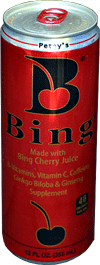Scary Food Additives
(Part 2 of 2)
In my column last week I told you about a couple of scary ingredients food companies use to make things look and taste better. Unfortunately, they may also cause cancer, increase your risk of heart attack, stroke and diabetes. This week I've got five more things you might want to avoid if you see them on a label.
Titanium dioxide paint pigment is mixed in food to make things appear "whiter." Because it's a mined substance, it's sometimes contaminated with lead.
 You'll find titanium dioxide in coffee creamers, icing and salad dressings. Take a look at a bottle of Ken's Steak House Lite Ranch Dressing. On the label of more than 30 ingredients is Titanium dioxide listed "for color" near the bottom. Just because it's a "Lite" dressing doesn't make it healthy. Consider switching to a vinaigrette instead.
You'll find titanium dioxide in coffee creamers, icing and salad dressings. Take a look at a bottle of Ken's Steak House Lite Ranch Dressing. On the label of more than 30 ingredients is Titanium dioxide listed "for color" near the bottom. Just because it's a "Lite" dressing doesn't make it healthy. Consider switching to a vinaigrette instead.
 Ginkgo biloba is an ingredient many beverage companies are proud to put on the label. It's widely promoted as a way to enhance memory, even though clinical trials show it doesn't work. What Ginkgo can do is interfere with blood clotting. That makes it dangerous for expectant mothers, anyone before or after surgery and people with bleeding problems like hemophilia.
Ginkgo biloba is an ingredient many beverage companies are proud to put on the label. It's widely promoted as a way to enhance memory, even though clinical trials show it doesn't work. What Ginkgo can do is interfere with blood clotting. That makes it dangerous for expectant mothers, anyone before or after surgery and people with bleeding problems like hemophilia.
To make matters worse, in 2013 the United States Government National Toxicology Program stated that there is "clear evidence" Ginkgo biloba caused liver cancer in male and female mice. There is a belief that it may cause cancer in humans as well.
That doesn't stop Bing cherry drink from proclaiming proudly on the front of the can that it's made with "Ginkgo Biloba." One can also has 10 grams of sugar, nearly a quarter of your daily supply. Skip the Ginkgo supplements.
 In more traditional sodas you find Caramel Coloring. It's a sugar compound heated together with ammonium compounds, acids or alkalis. It simulates the appearance of cocoa in baked goods, darkens meat and gravies while giving soft drinks a deep brown color.
In more traditional sodas you find Caramel Coloring. It's a sugar compound heated together with ammonium compounds, acids or alkalis. It simulates the appearance of cocoa in baked goods, darkens meat and gravies while giving soft drinks a deep brown color.
One of the contaminants that often occur when caramel coloring is produced with ammonia is 4-methylimidazole. The World Health Organization has declared that 4-methylimidazole is "possibly carcinogenic to humans" and the State of California's Environmental Protection Agency has listed ammonia-caramel coloring as a carcinogen under the state's Proposition 65.
![]() Even more worrisome than cancer-causing coloring is the extreme amount of sugar found in soft drinks with caramel coloring. Typical 20-ounce plastic bottles you find near check-out registers have 69 grams of sugar, more than the average American is supposed to take in from everything they eat and drink in a day. Drinking calories like these is one of the things that's devastating world health and waistlines.
Even more worrisome than cancer-causing coloring is the extreme amount of sugar found in soft drinks with caramel coloring. Typical 20-ounce plastic bottles you find near check-out registers have 69 grams of sugar, more than the average American is supposed to take in from everything they eat and drink in a day. Drinking calories like these is one of the things that's devastating world health and waistlines.
Cochineal extract and carmine are red colorings made out of the cochineal insect. Between 80,000 and 100,000 insects are boiled, dried out and mixed to become one kilo of dye. The dye is then used in red, pink or purple candy, yogurt, ice cream, drugs and cosmetics.
The primary problem is with people who are allergic to the insect. Since food companies simply list it as "artificial coloring" or "color added," there's no way to know which foods have it and which don't. When an unsuspecting consumer takes a bite, the effects can range from hives to life-threatening anaphylactic shock.
Allergies aren't the only problem. People who are vegetarians have no way of knowing if that bite of yogurt with "artificial coloring" is pink from the crushed bodies of insects.
Finally, there's castoreum, an extract from beaver anal glands. Beavers mix it with their urine to mark their territories. Food companies use it to make berry or vanilla flavoring in pudding, gelatins and yogurt.
Unfortunately, you won't see the word "castoreum" on the ingredient list, instead it's hidden under the innocent-sounding name "natural flavorings." There is no evidence castoreum is harmful, but that doesn't make it any less disgusting. Avoid foods that don't list every ingredient clearly on the label and hide behind generic terms like "natural flavorings" or "color added."
Call for a FREE Consultation (305) 296-3434
CAUTION: Check with your doctor before
beginning any diet or exercise program.
8/10/2013


